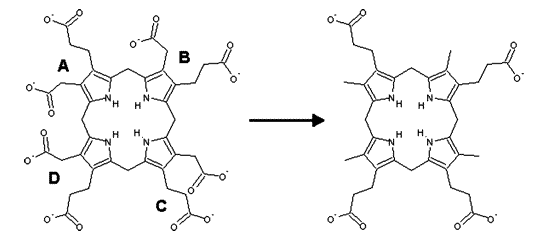
Uroporphyrinogen III decarboxylase
Encyclopedia
Uroporphyrinogen decarboxylase, also known as UROD, is an enzyme
that in humans is encoded by the UROD gene
.
biosynthetic pathway. This enzyme is responsible for catalyzing the conversion of uroporphyrinogen to coproporphyrinogen
through the removal of four carboxymethyl side chains.
Uroporphyrinogen III decarboxylase (UroD) is a homodimeric enzyme that catalyzes the fifth step in heme
biosynthesis: the elimination of carboxyl groups from the four acetate
side chains of uroporphyrinogen III
to yield coproporphyrinogen III
.
and hepatoerythropoietic porphyria
.
 UroD is regarded as an unusual decarboxylase, since it performs decarboxylations without the intervention of any cofactors, unlike the vast majority of decarboxylases. Its mechanism has recently been proposed to proceed through substrate protonation by an arginine
UroD is regarded as an unusual decarboxylase, since it performs decarboxylations without the intervention of any cofactors, unlike the vast majority of decarboxylases. Its mechanism has recently been proposed to proceed through substrate protonation by an arginine
residue . A 2008 report demonstrated that the uncatalyzed rate for UroD's reaction is 10-19 s-1, so at pH 10 the rate acceleration of UroD relative to the uncatalyzed rate, catalytic proficiency, is the largest for any enzyme known, 6 x 1024 M-1.

Enzyme
Enzymes are proteins that catalyze chemical reactions. In enzymatic reactions, the molecules at the beginning of the process, called substrates, are converted into different molecules, called products. Almost all chemical reactions in a biological cell need enzymes in order to occur at rates...
that in humans is encoded by the UROD gene
Gene
A gene is a molecular unit of heredity of a living organism. It is a name given to some stretches of DNA and RNA that code for a type of protein or for an RNA chain that has a function in the organism. Living beings depend on genes, as they specify all proteins and functional RNA chains...
.
Function
This gene encodes the fifth enzyme of the hemeHeme
A heme or haem is a prosthetic group that consists of an iron atom contained in the center of a large heterocyclic organic ring called a porphyrin. Not all porphyrins contain iron, but a substantial fraction of porphyrin-containing metalloproteins have heme as their prosthetic group; these are...
biosynthetic pathway. This enzyme is responsible for catalyzing the conversion of uroporphyrinogen to coproporphyrinogen
Coproporphyrinogens
Coproporphyrinogens are tetrapyrroles with four propionic acid groups and an equal number of substituted methyls.Coproporphyrinogen III is the most common variance...
through the removal of four carboxymethyl side chains.
Uroporphyrinogen III decarboxylase (UroD) is a homodimeric enzyme that catalyzes the fifth step in heme
Heme
A heme or haem is a prosthetic group that consists of an iron atom contained in the center of a large heterocyclic organic ring called a porphyrin. Not all porphyrins contain iron, but a substantial fraction of porphyrin-containing metalloproteins have heme as their prosthetic group; these are...
biosynthesis: the elimination of carboxyl groups from the four acetate
Acetate
An acetate is a derivative of acetic acid. This term includes salts and esters, as well as the anion found in solution. Most of the approximately 5 billion kilograms of acetic acid produced annually in industry are used in the production of acetates, which usually take the form of polymers. In...
side chains of uroporphyrinogen III
Uroporphyrinogen III
Uroporphyrinogen III is an metabolic intermediate in the biosynthesis of protoporphyrin. It is created by the enzyme uroporphyrinogen III synthase, and is converted into coproporphyrinogen III by the enzyme uroporphyrinogen III decarboxylase.-See also:...
to yield coproporphyrinogen III
Coproporphyrinogen III
In the metabolism of porphyrin, the enzyme uroporphyrinogen III decarboxylase generates coproporphyrinogen III from uroporphyrinogen III, and coproporphyrinogen III oxidase converts it into protoporphyrinogen IX....
.
Clinical significance
Mutations and deficiency in this enzyme are known to cause familial porphyria cutanea tardaPorphyria cutanea tarda
Porphyria cutanea tarda is the most common subtype of porphyria. The disorder results from low levels of the enzyme responsible for the fifth step in heme production. Heme is a vital molecule for all of the body's organs...
and hepatoerythropoietic porphyria
Hepatoerythropoietic porphyria
Hepatoerythropoietic porphyria is a very rare form of hepatic porphyria caused by a disorder in both genes which code Uroporphyrinogen III decarboxylase .It has a similar presentation to porphyria cutanea tarda , but with earlier onset...
.
Mechanism
At low substrate concentrations, the reaction is believed to follow an ordered route, with the sequential removal of CO2 from the D, A, B, and C rings, whereas at higher substrate/enzyme levels a random route seems to be operative. The enzyme functions as a dimer in solution, and both the enzymes from human and tobacco have been crystallized and solved at good resolutions.
Arginine
Arginine is an α-amino acid. The L-form is one of the 20 most common natural amino acids. At the level of molecular genetics, in the structure of the messenger ribonucleic acid mRNA, CGU, CGC, CGA, CGG, AGA, and AGG, are the triplets of nucleotide bases or codons that codify for arginine during...
residue . A 2008 report demonstrated that the uncatalyzed rate for UroD's reaction is 10-19 s-1, so at pH 10 the rate acceleration of UroD relative to the uncatalyzed rate, catalytic proficiency, is the largest for any enzyme known, 6 x 1024 M-1.
Further reading


